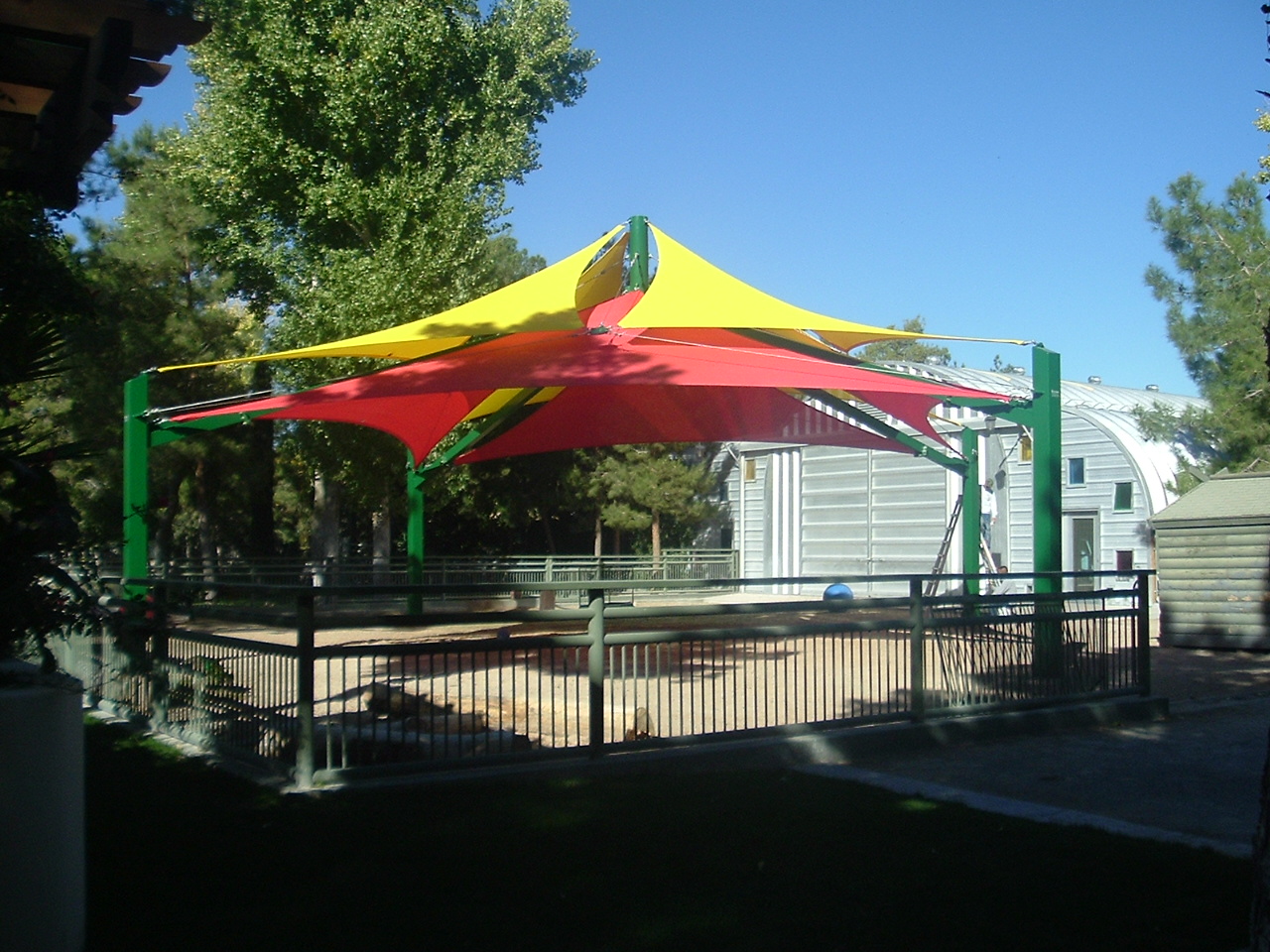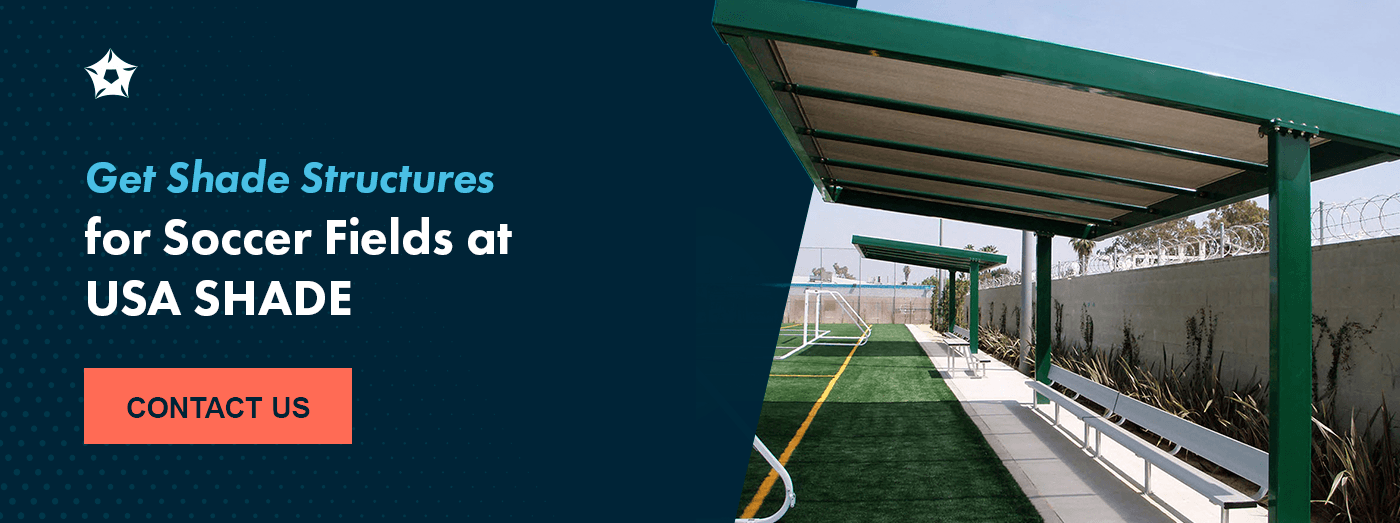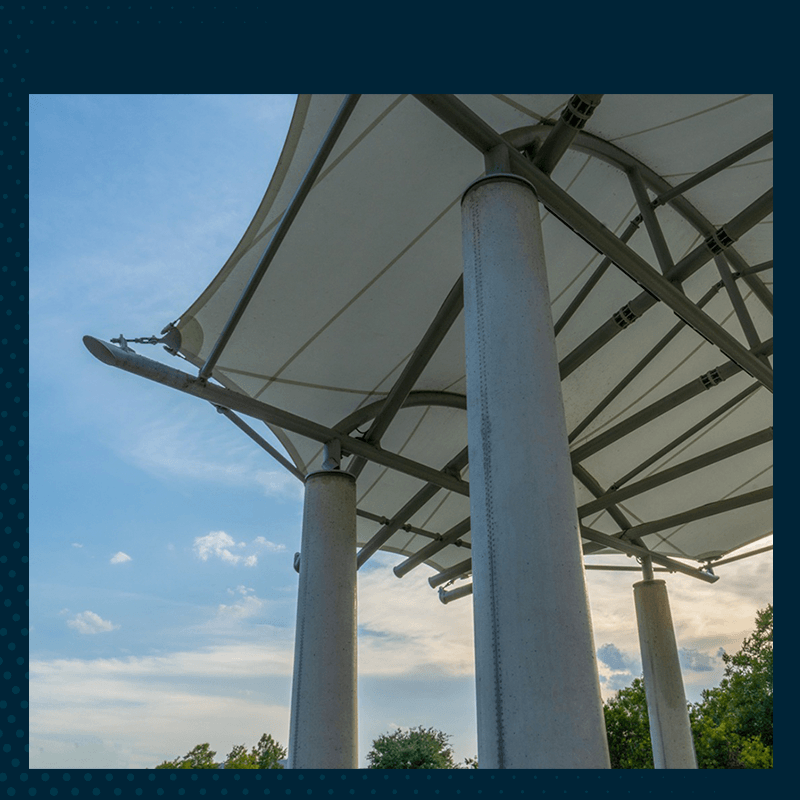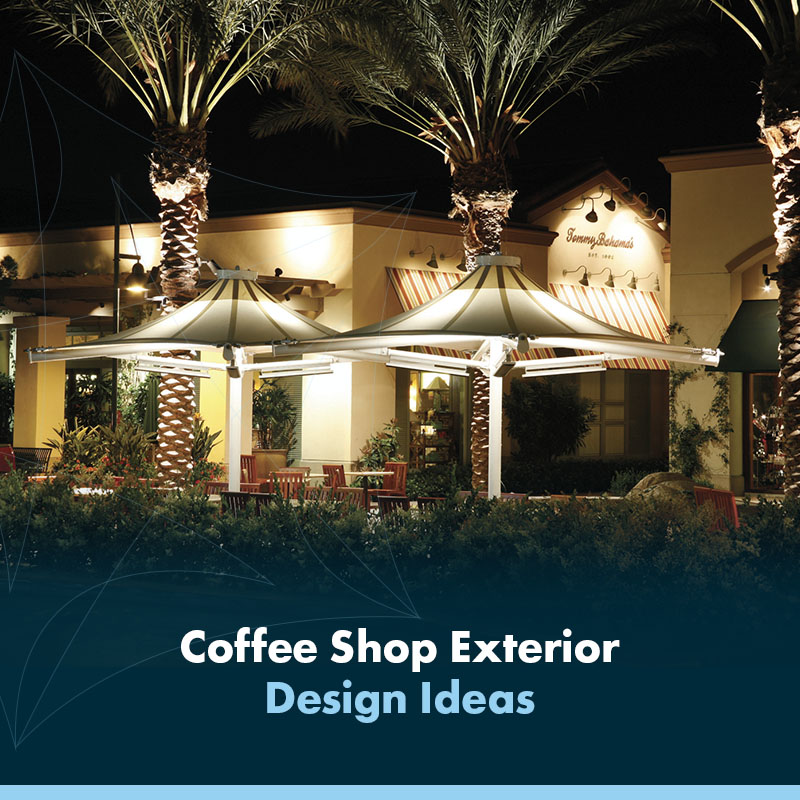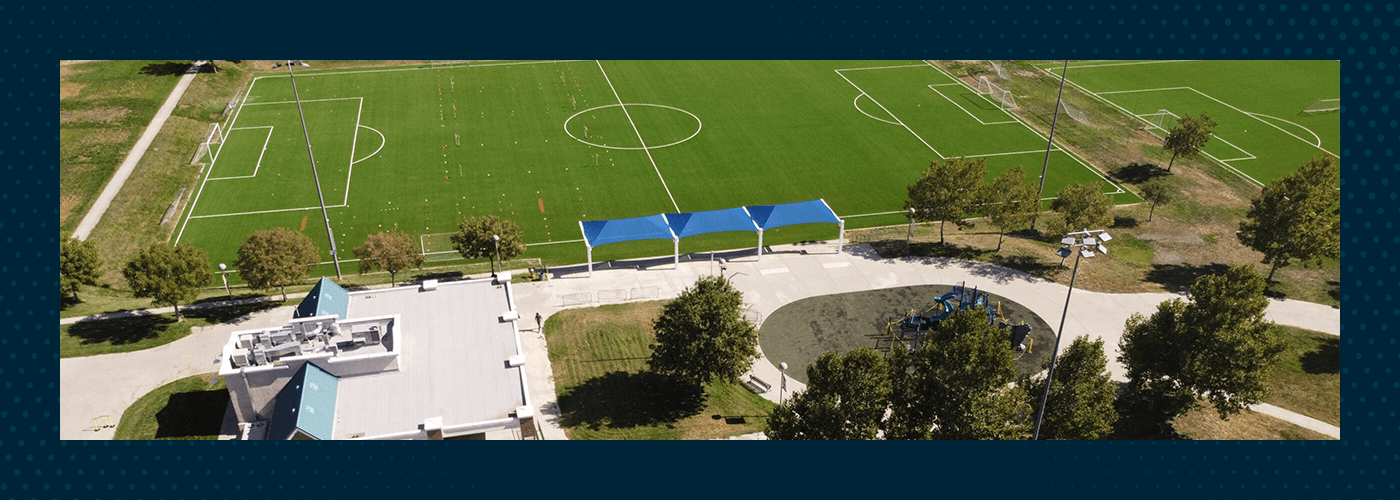
A perfectly designed soccer field is more than a playing surface — it encompasses all aspects of the game, catering to the needs of players and spectators. It’s an arena that offers players comfort, safety and convenience as they display their skills while equally providing these qualities to those enjoying the game from the sidelines.
A soccer field must be functional and inclusive to cater to the needs of everyone present. As a result, soccer field design involves various considerations essential for continued satisfaction and long-term usability. This guide highlights all of the elements of soccer field design.
Soccer Field Dimensions and Layout
According to the Fédération Internationale de Football Association (FIFA), the international governing body for soccer, a soccer field, specifically the field of play, must be rectangular and marked with continuous lines. These peripheral lines, called touch lines and goal lines, should be 115 yards long and 74 yards wide.
These dimensions are used in senior international soccer fields, but they aren’t entirely fixed. Both FIFA and the International Football Association Board (IFAB) stipulate 109-120 yards long and 70-82 yards wide for senior soccer fields. In the United States, the United States Soccer Federation (USSF) regulates soccer, but the body still adheres to IFAB guidelines regarding field dimensions. For pitches designed for recreational tournaments inside the U.S., the touch lines fall between 98 and 121 yards, while the goal lines fall between 49 and 100 yards.
All soccer fields are split into two halves marked by a circled center point, the circle of which has a 10-yard radius.
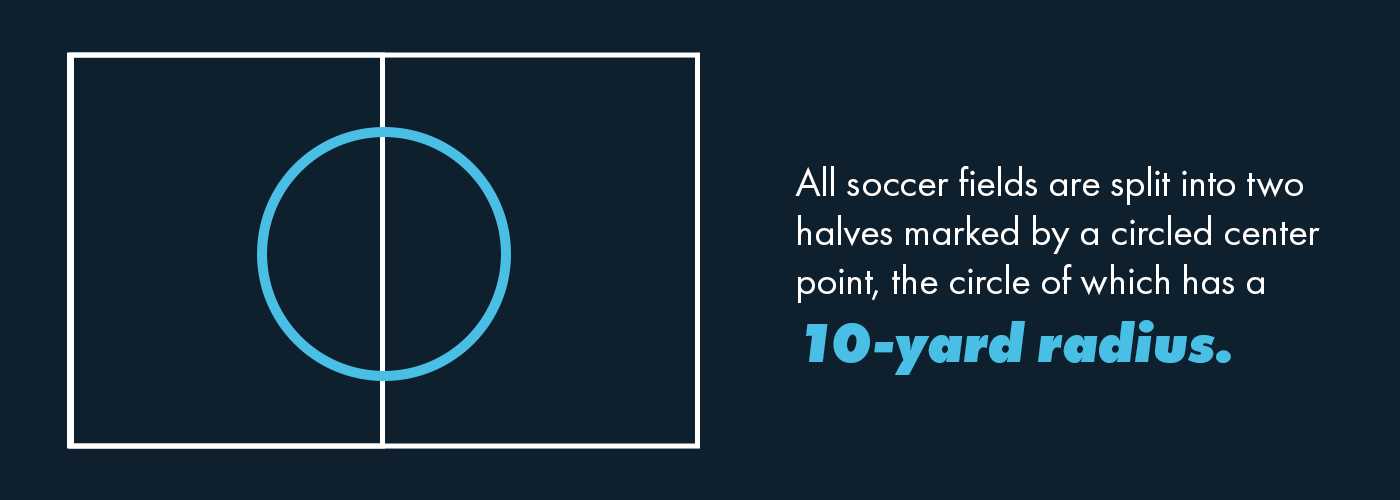
Inner Field Markings
Here’s a breakdown of other areas of the pitch and their standard dimensions:
- Goal area: This is a rectangular section next to the goal post that measures 6 yards wide and 12 yards long. At the center of each goal area sits upright goal posts with a horizontal crossbar.
- Penalty box: The penalty box encloses the goal area and has a width line that extends 18 yards into the play area from the goal line. It’s approximately 44 yards long. The rectangular area contains the penalty mark, which stretches 12 yards from the goal line.
- Penalty box arc: This is an arc or curve at the head of the penalty box, which measures 10 yards from the penalty mark.
- Corner arc: These arcs indicate where corner kicks originate. The arc is a quarter circle with a 1-yard radius that sits in all four corners of the field.
Technical Area
This is the area at the side of the pitch designated as a seating area for the two team officials. It seats a restricted number of people and is regulated by specific IFAB guidelines. The technical area includes:
- Two separate seating areas for each team.
- Benches covered by high-quality shade structures that can withstand the elements, debris and objects.
- Fixtures that are identical for both teams.
Safety Standards for Soccer Fields
The infrastructure and systems that promote safety for players and spectators are key parts of soccer field construction.
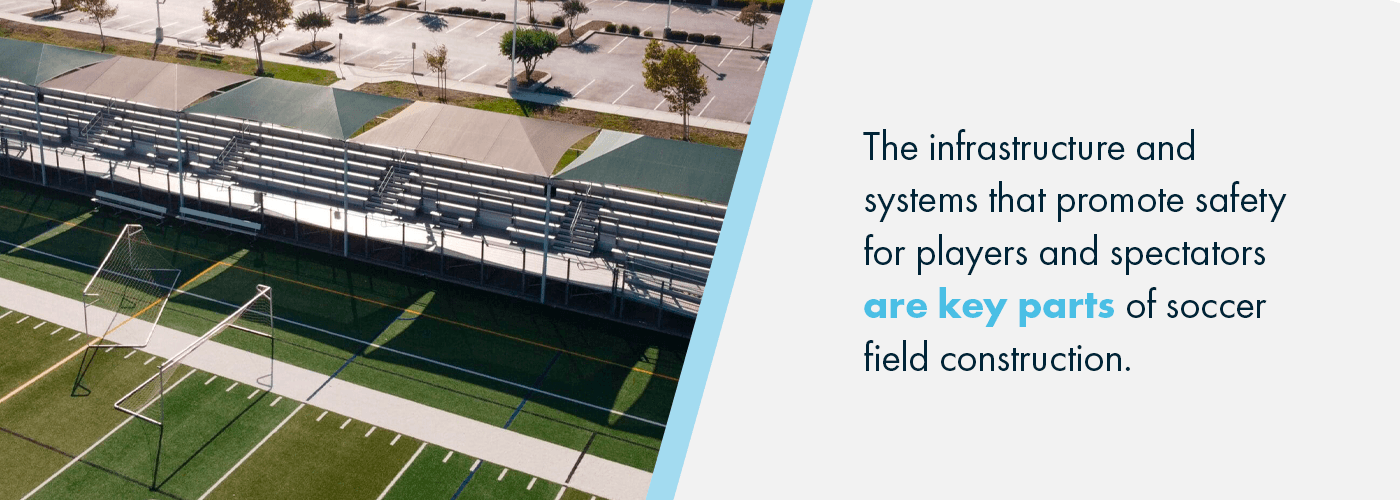
Safety Measures for Players
Here’s a breakdown of player-focused safety measures:
- Playing field: The playing surface must adhere to soccer standards regarding evenness and traction to prevent serious trips, skidding and falls. Schedule inspection for the natural and artificial turf to ensure compliance.
- Goalpost padding: To minimize the risk of injuries when players bump into the goalposts, cover them with high-quality protective padding like compressed foam.
- Run-off area: Design an adequate run-off area or buffer zone outside the playing field to help players slow down and prevent collisions with barriers.
- Adequate lighting: Since games often occur at night, create ideal lighting areas with powerful lighting fixtures that ensure player visibility.
- Medical services: Players and officials need an accessible medical area near the pitch, fully equipped with emergency supplies like first-aid kits and stretchers.
Safety Measures for Spectators
Spectators usually turn up in large numbers, taking up much of the stadium’s seating area. The concentration of a large group of people in a listed space increases safety risks. These measures promote the safety of spectators:
- Fire detection systems and equipment: The stadium should accommodate robust fire detection and warning systems that can detect and identify the location of a fire to facilitate quick intervention. Portable firefighting equipment like extinguishers and fire blankets are necessary. Indoor grounds with rooms and shade structures for bleachers will need additional systems like sprinklers, hose reels and smoke controls.
- Emergency evacuation: Both indoor and outdoor facilities need sufficient and unobstructed exit routes. These are critical during emergency evacuations and are necessary in the event of a fire, stampede or riot.
- Medical facilities: Like players, spectators need a dedicated area for medical emergencies. These areas must be easily accessible to emergency service providers.
Selecting the Right Soccer Turf
One key decision during soccer field design is the playing surface. Traditional natural grass and artificial or synthetic turf are the two options for surface materials. Both are popular solutions with unique advantages and disadvantages.
Natural Grass Field vs. Synthetic Turf: Comparison
| Natural Grass | Synthetic Turf | |
|---|---|---|
| Durability | Less durable due to the inability to withstand heavy use and weather conditions. | Can withstand all weather types and continous activities. |
| Performance | Comfortable but susceptible weather conditions, leading to mud, hardness and unevenness. | More reliable, offering fluid game play due to a consistent surface. |
| Safety | Can be slippery in certain weather conditions, but its softness lowers the risk of injuries. | Good traction, but increases the risk of contact burns and abrassions. |
| Maintenance needs | Requires year-round upkeep involving regular mowing, irrigation, pest and weed control, fertilizer application, aeration and seeding. | Requires periodic maintenance to remove litter and debris, regulate the infill, fix loose seams, and level dips and bumps. |
| Aesthetics | Natural look and feel. | Clean and consistent look year-round that closely resembles real grass. |
| Cost | Initial costs vary depending on seed quality, labor, and other installations, such as an irrigation system. High long-term maintenance costs. | Initial setup cost is higher than natural grass but the cost of ongoing maintenance is lower. |
Effective Drainage Systems
Proper drainage is necessary to maintain the quality of soccer fields. It prevents water accumulation issues like flooding and localized puddles, which make playing challenging and heighten the risk of slips and falls. Besides eliminating excess water on the surface, a good drainage system maintains soil compaction and discourages fungi and bacteria from thriving in the moist environment.
Below are some of the common drainage solutions for soccer fields:
Surface Drainage
Allowing the water to run off by itself is an effective drainage solution. This approach involves leveraging gravity to force water out of the pitch by shaping the field with a slight slope. You can achieve reliable natural surface drainage by implementing a 1% slope or crown to support other drainage techniques. Keep in mind that a higher crown isn’t suitable, as it impacts ball movement against the slope.
Sub-Surface Drainage
Sub-surface drainage systems remove excess water from the field through pathways or an infiltration system in the soil profile. These systems are ideal for soccer fields because they don’t impact the playing surface. Common sub-surface methods for draining sports fields include:
- Pipe drains
- Gravel layers
- French drains
- Trackside drains
- Strip drains
Lighting for Soccer Fields
Lighting is one of the key considerations during soccer field construction. Lighting standards vary based on the level of play, such as professional, semi-professional and recreational games. Soccer governing bodies like FIFA recommend a minimum of 1,000 lumens per square meter (lux) for professional games. Here are all FIFA lighting standards and their respective minimum lighting grade:
- Standard A: 1,000 lux
- Standard B: 650 lux
- Standard C: 350 lux
- Standard D: 250 lux
Lighting Poles and Lighting Systems
Other factors to consider besides illuminance power are the number of poles on the field and lighting systems. The number of poles is directly connected to proper light distribution and uniformity. Lighting uniformity means proper balance to avoid shadows and glare, both of which hinder visibility. While eight poles at the corners and sides are ideal for professional soccer fields, recreational fields can get by with four poles.
A metal halide light, a type of high-intensity gas discharge (HID) light with high luminous power, is a common lighting system for sports fields across the country. The other option is light-emitting diode (LED) technology, which comes with numerous benefits that give it an edge over traditional lighting solutions. While both systems have a powerful light output, LED is more energy-efficient, offering up to 90% energy efficiency.
Enhancing Spectator Comfort
While you may focus on the field where the action takes place, you should also consider facilities that contribute to spectator convenience and a positive experience. Detailed soccer field specifications address spectator comfort, making the facility attractive to fans and boosting event success. Considering bleachers are the primary space spectators occupy during games, it’s important that their design balances desired seating capacity and comfort.
Assess factors like legroom, seat size and ergonomics. You’ll also want to plan out weatherproof shade structures, restrooms and concession stands. Whether it’s a stadium or open grounds, providing spectators with these aspects and facilities creates an enjoyable environment.
Additionally, remember spectators who may find it challenging to access various facilities due to physical limitations. Improve accessibility by providing features such as wheelchair-accessible seating, restrooms and exit routes, alongside other Americans with Disability Act requirements. Designing the field to be accessible to everyone promotes inclusivity and maintains compliance.
Benefits of Shade Structures for Soccer Fields
Soccer fields require protective features against the weather. Adding a soccer field shade, especially covering the bleachers, technical area and other benches, safeguards spectators and officials from the elements. Here are some of the benefits of adding shade structures to soccer fields:
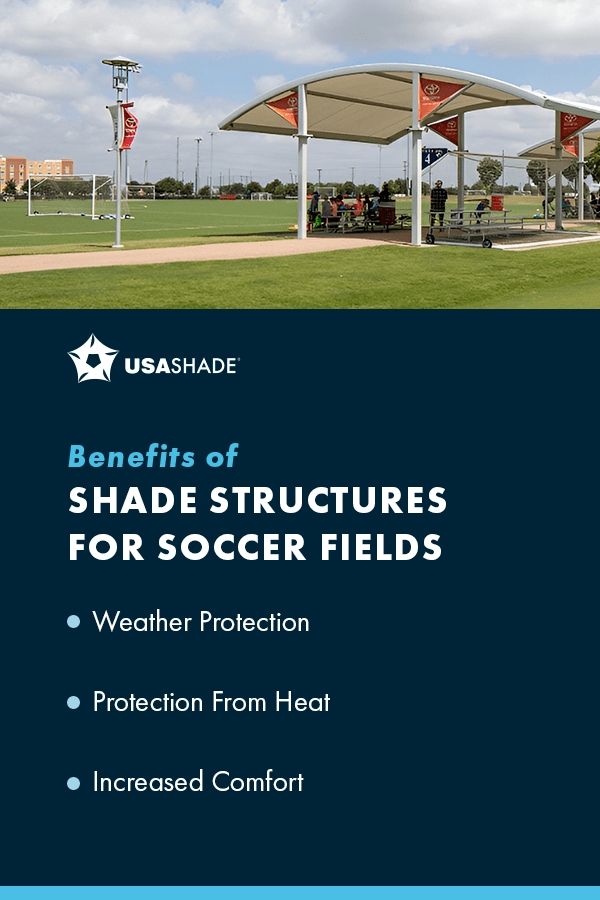
Weather Protection
Soccer fields are exposed to the brunt of the elements. As the architect responsible for the construction project or the facility manager, consider commercial shade structures to shelter visitors from unpredictable weather conditions.
High-quality structures from reliable manufacturers protect against scorching heat and the sun’s harmful UV rays. In addition to the sun, rainy weather and snow can make watching and enjoying a soccer match difficult and even impossible. Installing waterproof shade structures over the bleachers and benches provides attendees with a dry seating area free from precipitation.
Protection From Heat
Both indoor facilities and outdoor grounds are susceptible to overheating on hot summer days. Unfortunately, not all shade structures can deflect the sun’s heat, as that depends on material quality and sun-blocking technology. Poor-quality shade materials may offer shelter while letting heat through, making the sheltered area uncomfortable. Choosing the most appropriate structure designed for heat prevention ensures sheltered areas remain cool on hot days.
Increased Comfort
Shade structures make outdoor spaces more inviting and comfortable, adding visual appeal to the facility’s design. Even when the weather is nice, a facility that already has shelter in place gives visitors the assurance they’re secure in case the weather changes during a match, making them more comfortable. Shade structures also make the space inclusive for spectators of all ages and backgrounds.
Incorporating Sustainability in Soccer Field Design
Incorporating eco-friendly approaches during soccer field construction may be a priority. Some examples of sustainability during the design and construction phase include:
- Sourcing eco-friendly and recycled materials for various structures around the field.
- Optimizing the facility design to improve ventilation.
- Installing solar-powered lighting fixtures to lower energy consumption and reliance on the electricity grid.
- Implementing irrigation systems that optimize water usage to prevent wastage, such as rainwater harvesting.
- Using eco-friendly waste management strategies like waste segregation recycling bins and water-efficient restrooms.
Get Shade Structures for Soccer Fields at USA SHADE
When designing a soccer field, it’s important to consider both the players and spectators and what you can do to improve their experience. Key factors like safety standards, turf choice, drainage, lighting and convenience facilities provide a satisfactory environment for everyone. While shade structures aren’t enforced by regulatory bodies, installing them allows you to balance functionality, safety and comfort.
At USA SHADE, we understand that every project is unique, which is why we offer custom shade structures designed to meet your facility’s specific needs. We’re an industry leader with over 25 years of experience in shade structure design and technology. Explore USA SHADE’s solutions for durable and stylish shade structures. You can also contact our team today to discuss your project’s needs!


